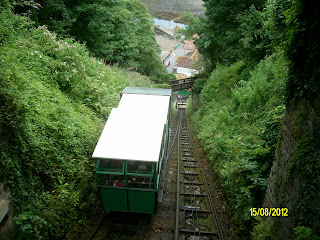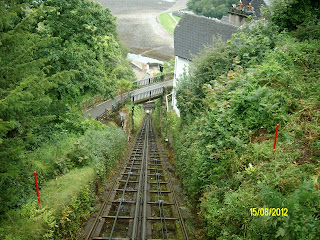As
we had use of Dan's car, we all squeezed in and travelled up to the
small and charming town of Lynton. Made famous by the travelling
curiousity of the Victorians, they would have come by the narrow
gauge railway from Barnstaple.
The
former splendour of the time can be seen by their majestic Town Hall.
How
to get down from Lynton to the sea front?
The
Victorians simply built a vertical railway (actually about 45
degrees). Constructed in 1888 and completed in 1890, it drops the
400ft to the sea front at Lynmouth. It runs on the gravity of water
from a tank fed by a local stream. Needing 2 drivers via a bell
system, the top carriage tank is filled with water. When ready, the
lower driver winds off the brake and releases water – when the
tanks balance the rail carriages begin to move up to about 12mph when
a governor puts on the brake. 400ft in about 4 minutes – all with a
renewable source! Not bad for 1888!
 | ||
|
Passing
round each other …
|
Lynmouth
has special significance for us Woolfords as this is where my Mum and
Dad came for their honeymoon in 1947 (I think?). My Dad said they
stayed at the rather grand Tors Hotel.
As
children we came to visit many times (and we have brought our
children here in turn).
The
visits always had a poignancy for us as our parents re-called the
terrible flood disaster of 1952 when an extremely severe storm caused
a flash flood sweeping down the valley at night and 34 people died. A
small museum recalls the events of that night and the aftermath.
As
it happens, we were there on the 60th Anniversary of that
fateful night 15th August 1952. |
|
This
Rhienes Tower was rebuilt after the floods, as was the harbour.
|
 |
|
Cottages
that did survive with a holidaymaker
|







No comments:
Post a Comment